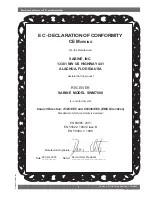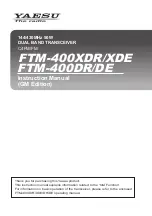
12
Sabine 2.4 GHz Smart Spectrum
®
Wireless
© 2007 Sabine, Inc.
SELECT
D OW N
U P
O N /OFF
O N /M UT E
O N /ON
4. TRANSMITTER OPERATION
4.1. First step
Before you begin, let’s look at a few basics regarding your transmitters. The
handheld mic is ready to go — the microphone and transmitter are com-
bined in one unit. To use the belt pack transmitter, however, you will have to
connect a lavalier or headworn microphone (or instrument pickup) to its
input. Sabine lavalier and headworn mics, and Sabine’s guitar/instrument
connector (SW70G-TA4) come equipped with the proper TA4F connector,
and are ready to plug right in. Be sure to line up the pins properly — do not
force the connector into the belt pack.
If you are using a different microphone with the Sabine belt pack, please
refer to the Appendix A for the required wiring plan. Failure to use the
proper wiring scheme may damage your mic or the belt pack, and void your
warranty.
Use the clip on the back of the belt pack transmitter to attach it to your belt or
clothing. The spring clip can be removed and reversed, to allow the trans-
mitter and antenna to point either up or down in its clipped-on position. You
can also remove the clip if you choose to keep the transmitter in your pocket.
NOTE: it is essential that transmitters retain a line-of-sight relationship with
the receiver antennas.
4.2. Displays and Settings
Your Sabine 2.4 GHz Smart Spectrum handheld microphone and belt pack
transmitter have many powerful features, all of which are easily monitored
(using the transmitter LCD display) and adjusted. The controls and dis-
plays for both handheld and belt pack transmitters are almost identical in
function, though positioning differs (compare figures 4b & 4c). The LCD
display and one control switch are located on the exterior of the transmitters.
A more powerful set of recessed controls is located under the hinged access
panel, to prevent accidental or inappropriate alteration of settings.
4.2.1. LCD Display
When the transmitter is first turned on, it shows an initial test screen (Fig.
4f), followed by the default screen (Fig. 4g). The LCD also reverts to this
default display within a few seconds after any programming changes are
made with the recessed controls. The default LCD display always shows
transmission channel, audio level, and battery voltage level; additional
information will appear to indicate important changes caused either by
user adjustments, or automatically as transmitter status changes.
Fig. 4a
External
Switch
Fixed
Antenna
TA4F connector
Belt clip
1. Select Button
2. Up Button
3. Down Button
4. Programmable Control of External Switch
5. External Switch
6. Recessed control and battery compartments
Fig. 4c SW75-T Transmitter Control Setting Buttons
6
Fig. 4b SW70-H1 Handheld Control Setting Buttons
2
4
5
1
3
Transmitter Operation
1
2
3
4
6













































